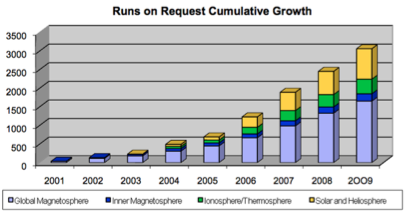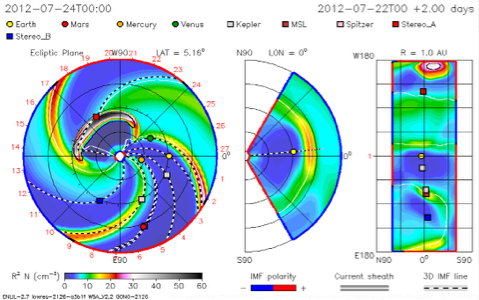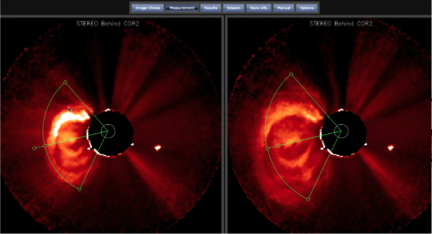Community Coordinated Modeling Center
Community Coordinated Modeling Center
The Community Coordinated Modeling Center (CCMC) is a U.S. interagency activity aimed at research in support of the generation of advanced space science and space weather models. The CCMC consortium consists of NASA, NSF, the U.S. Air Force (USAF) Weather Agency, Directorate of Weather, Space and Missiles System Center, the Air Force Research Laboratory, the Air Force Office of Scientific Research, the Office of Naval Research, and NOAA. CCMC's central facility is located at GSFC. The CCMC is supported primarily by NASA and by NSF. At present, CCMC has a diverse staff, consisting of space and computer scientists and information technology professionals.
The first function of the CCMC is to provide a mechanism by which research models can be validated, tested, and improved for eventual use in space weather forecasting, such as needed for NASA's Vision for Space Exploration. Models that have completed their development and passed metrics-based evaluations and science-based validations are being handed off to the forecasting centers at NOAA and the U.S.Air Force for space weather applications. In this function, CCMC acts as an unbiased evaluator that bridges the gap between space science research and space weather applications.

Overview of models at the CCMC
As a second, equally important function, the CCMC provides to space science researchers all over the world the use of space science models, even if they are not model owners themselves. This service to the research community is implemented through the execution of model "runs-on-request" for specific events of interest to space science researchers at no cost to the requestor. Model output is made available to the science customer by means of tailored analysis tools and data dissemination in standard formats. Through this activity and the concurrent development of advanced visualization tools, CCMC provides to the general science community unprecedented access to a large number of state-of-the-art research models. The continuously expanding model set includes models in all scientific domains from the solar corona to Earth's upper atmosphere.
Science Support
CCMC science services are provided through Web access (http://ccmc.gsfc.nasa.gov). Here, users can request calculations from more than 25 modern space science models, which are hosted at the CCMC through very positive collaborations with their owners.
After a run request, a user will be notified via e-mail once the calculation is complete. At this time, the run can be analyzed via tailored visualization tools, again via Web access. These tools have been continuously refined for more than 10 years, primarily in response to user requests. Recently added capabilities include Poynting flux calculations, model outputs, field-line tracing along satellite trajectories, movie generation, and time line, and topology capabilities.

Cumulative Run-on-Request (RoR) growth through 2009. The utilization of CCMC RoR services continues to grow rapidly.
CCMC-run analysis services are also used heavily. In 2009, an average month saw about 4,000 visitors, and nearly 20,000 visits, and similar statistics apply to 2010. Visualization requests typically lead to the creation of tens of thousands of visualization pages each month. These monthly averages continue to increase from year to year.
Furthermore, the CCMC staff is continuing to develop new means to support users in their scientific studies. In the realm of visualization, OpenDx-and JAVA-based visualization with enhanced 3D capabilities is now available for a number of different model outputs. With both OpenDx and IDL based 3D visualizations, users can request output in Virtual Reality Modeling Language (VRML) form, which permits real-time in-depth analysis of complex 3D structures.
Further science services at the CCMC include the provision of the Model Web, where a large set of empirical or analytical models, such as the International Reference Ionosphere (IRI), are available for interested users for download or execution. CCMC is also supporting space science missions, for example STEREO, THEMIS, and MMS. Science mission support includes background science information derived from routine runs, or calculations in support of specific campaigns or specific science objectives.
As in the past, the future of CCMC services will be shaped by the needs of the science community. Community input is solicited formally and informally, through meetings, tailored workshops, and personal contacts.
Space Weather Research Center
The Space Weather Research Center (SWRC) is an activity within CCMC providing space weather services to NASA’s robotic missions, prototyping of space weather tools and models and educating the next generation of space weather experts and forecasters. SWRC was conceived as a result of Space Weather & NASA Robotic Mission Operations Workshop that detailed the robotic mission needs and identified the need for space weather services tailored for the robotic arm of agency’s space exploration.
SWRC mission is “Addressing the space weather needs of NASA's robotic missions through experimental research forecasts, notification, analysis, and education. Bringing space weather knowledge to the public. ”
Space weather service to NASA’s robotic missions
Since the needs of different NASA Robotic Missions are unique, we provide a broad range of tools, products, and services to meet the dynamic requirements of our customers.
Providing accurate real-time experimental research forecasting of both large-scale and local space environments - and their probable impacts for missions is an essential component, and we achieve this by providing routine research forecasts (see figure below), notifications, space weather analysis, and spacecraft anomaly resolution support to all NASA robotic missions.

SWRC prediction of the July 23rd, 2012 super coronal mass ejection event. The event impacted STEREO A spacecraft.
SWRC also arranges annual NASA Robotic Missions & Space Weather Workshops. 5th workshop will take place September 2013. The workshops provide an opportunity for mission operators to exchange information about space weather concerns and provide feedback to SWRC about latest space weather needs. Workshops also allow SWRC to educate users about latest space weather capabilities.
Prototyping
One of the key elements of SWRC activities is the prototyping tools developed and models implemented by CCMC. Prototyping of these tools and models in a real-time environment allows validation and verification of these new capabilities as well as identification of possible improvements. An example of tool being prototyped is the Stereo Analysis Tool shown below. SWRC team has been using the tool for a number of years and provided testing and suggestions for numerous improvements made to the tool over the years.

Stereo Analysis Tool that is being used and prototyped by SWRC forecasters on a day-to-day basis.
